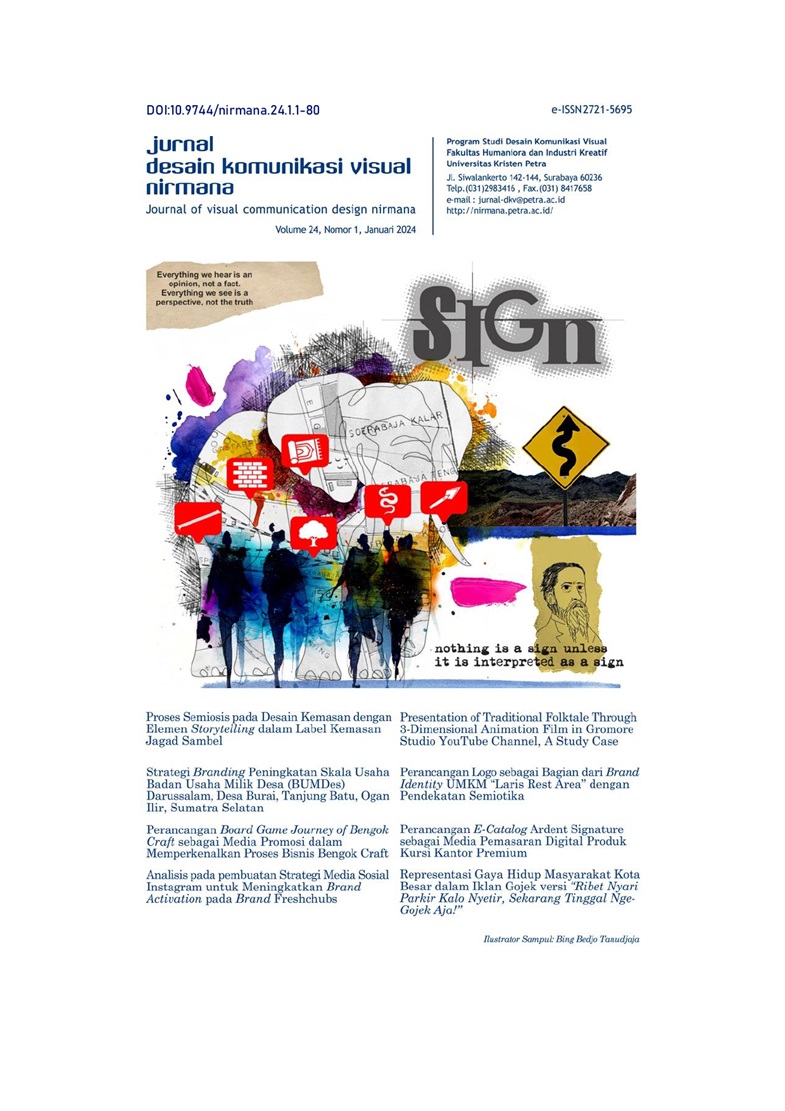Perancangan Logo sebagai Bagian dari Brand Identity UMKM “Laris Rest Area” dengan Pendekatan Semiotika
 :
:
https://doi.org/10.9744/nirmana.24.1.48-59
Keywords:
identitas merek, Indonesia, rumah makan tradisional Jawa, Usaha Mikro Kecil Menengah (UMKM)Abstract
Beriringan dengan program pemerintah yang mendukung berkembangnya jiwa bisnis masyarakat, maka persaingan antar Usaha Mikro Kecil Menengah (UMKM) semakin kompetitif. Sehingga setiap UMKM perlu membangun identitas kuat dan jelas sebagai pembeda dengan merek lain. Sebagai UMKM di bidang kuliner yang baru saja dirintis, Laris Rest Area tentu memerlukan identitas merek yang mampu mengenalkan, membedakan, dan menanamkan citra pada calon konsumen. Penelitian ini bertujuan untuk mengembangkan brand identity yang berfokus pada UMKM Laris Rest Area di Karanganyar, Jawa Tengah melalui perancangan logo. Perancangan logo dilakukan menggunakan pendekatan trikotomi bertingkat semiotika Charles Sanders Peirce. Trikotomi bertingkat menjadi sarana untuk menghasilkan strategi visual yang efektif sesuai dengan citra yang ingin disampaikan. Metode yang digunakan adalah metode kualitatif: wawancara, observasi, literatur, dan focus group discussion. Dengan adanya penelitian ini maka dihasilkan logo UMKM Laris Rest Area yang dapat digunakan untuk menyampaikan citra brand yaitu tradisional Jawa, klasik, kebersamaan, hubungan yang erat. Identitas dan diferensiasi yang menonjol membuat UMKM Laris Rest Area menjadi lebih dikenal dan diingat dibanding UMKM lainnya di Mojosongo, Karanganyar yang tidak memiliki logo.
References
Aaker, D. A., & Joachimsthaler, E. (2012). Brand Leadership. Simon and Schuster.
Agres, S. J., & Dubitsky, T. M. (1996). Changing Needs For Brands. Journal of Advertising Research, 36(1), 21-30.
Bauer, A. A. (2002). Is What You See All You Get?. Journal of Social Archaeology, 2, 1.
Budiman, K. (2011). Semiotika Visual: Konsep, Isu, dan Problem Ikonisitas. Yogyakarta: Jalasutra.
Centeno, E., Hart, S., & Dinnie, K. (2013). The Five Phases of SME Brand-Building. Journal of Brand Management, 20(6), 445-457.
Ciechomski, W. (2020). Creating and Positioning the Image of a Territorial Unit. Zeszyty Naukowe. Organizacja i Zarządzanie/ Politechnika Śląska.
De Chernatony, L., & Dall'Olmo Riley, F. (1998). Defining a "Brand": Beyond the Literature with Experts' Interpretations. Journal of marketing Management, 14(5), 417-443.
Eco, U. (2011). Teori Semiotika: Signifikasi Komunikasi, Teori Kode, Serta Teori Produksi-Tanda. Yogyakarta: Kreasi Wacana.
Everaert-Desmedt, N. (2019). Peirce’s Semiotics. In An Introduction to Applied Semiotics (pp. 241-249). Routledge.
Falcidieno, M. L. (2020). About Sound Mark: Considerations of Identity Connotations. IMG Journal, (2), 116-127.
Firmansyah, Anang. (2019). Pemasaran Produk dan Merek (Planning and Marketing). Pasuruan: CV. Penerbit Qiara Media.
Ghodeswar, B. M. (2008). Building Brand Identity in Competitive Markets: a Conceptual Model. Journal of product & brand management, 17(1), 4-12.
Hermanto, Y. A. L., & Rabani, R. (2020). Dinoyo's Ceramic Mascot As a Support of Brand Identity. KnE Social Sciences, 503-513.
Jin, C., Yoon, M., & Lee, J. (2019). The Influence of Brand Color Identity on Brand Association and Loyalty. Journal of Product & Brand Management. 28 (6)
Kress, G., & van Leeuwen, T. (2016). Semiotics and visual communication: Concepts and practices. Routledge.
Keller, K. L. (2023). Looking Forward, Looking Back: Developing a Narrative of the Past, Present and Future of a Brand. Journal of Brand Management, 30 (3), 1-8.
Krake, F. B. (2005). Successful Brand Management in SMEs: A New Theory and Practical Hints. Journal of Product & Brand Management. 14 (4), 228-238.
Laksmi, V. (2008). Bentuk, Fungsi, dan Makna Simbolis Motif Kain Batik Sidomukti Gaya Surakarta : Kontinuitas dan Perubahannya (Doctoral dissertation, Universitas Gadjah Mada).
Magnis-Suseno, F. (1984). Etika Jawa. Sebuah Analisa Falsafi tentang Kebijaksanaan Hidup Jawa. Penerbit PT Gramedia.
Mangunwijaya, Y. B. (2009). Wastu Citra: Pengantar ke Ilmu Budaya Bentuk Arsitektur, Sendi-Sendi Filsafatnya, Beserta Contoh-Contoh Praktis. Jakarta: PT Gramedia Pustaka Utama.
Meindrasari, D. K., & Nurhayati, L. (2019). Makna Batik Sidomukti Solo ditinjau dari semiotika sosial Theo Van Leeuwen. WACANA: Jurnal Ilmiah Ilmu Komunikasi, 18(1), 57-67.
Minakata, K., & Beier, S. (2022). The dispute about sans serif versus serif fonts: An interaction between the variables of serif and stroke contrast. Acta Psychologica, 228, 103623.
Muhonen, T., Hirvonen, S., & Laukkanen, T. (2017). SME brand identity: its components, and performance effects. Journal of Product & Brand Management. 26 (1), 52-67.
Pateda, M. (2001). Semantik leksikal Ed. II. Jakarta: Rhineka Cipta.
Proy, G. (2002). Sound and sign. Organised Sound, 7(1), 15-19.
Raposo, D., Neves, J., Fátima Peres, M. D., Paiva, T., Amaral, M., Silva, J., & Silva, F. M. D. (2020, July). Visual identity design as a cultural interface of a territory. In International Conference on Applied Human Factors and Ergonomics (pp. 65-72). Springer, Cham.
Romaniuk, J., Sharp, B., & Ehrenberg, A. (2007). Evidence Concerning the Importance of Perceived Brand Differentiation. Australasian Marketing Journal, 15(2), 42-54.
Romdhoni, A. (2019). Semiotik Metodologi Penelitian. Depok: Literatur Nusantara.
Rosandini, M., & Syafrudin, I. (2017). Pengolahan Motif Batik Perpaduan Unsur Tradisi Jawa dan Jepang. Jurnal Rupa, 2(2), 138-138.
Sobur, A. (2017). Semiotika Komunikasi. Bandung: Remaja Rosdakarya.
Tangmanee, C., & Rotworaphorn, T. (2014). Perceived Legibility of Onscreen English Fonts: An Exploration Into Readers and Font Types. Journal of Global Business Management, 10(2), 25.
Tinarbuko, S. (2008). Semiotic of Public Service Advertisement. Indonesian Journal of Communication Studies, 1(2), 63680.
Downloads
Published
How to Cite
Issue
Section
License
Copyright (c) 2024 Kartika Prasetya Purnamasari, Raphael Ramanandha Putra Deta, Pedro Fernandes, Ian Griffin Prawiromaruto

This work is licensed under a Creative Commons Attribution 4.0 International License.
- Jurnal Desain Komunikasi Visual Nirmana has the right of first publication while the author(s) retains copyright and the right to share and redistribute the work under a Creative Commons Attribution License. This license allows others to freely share and adapt the work, provided that they acknowledge the work's authorship and its initial publication in this journal.
- Upon publication, the author(s) agrees to the journal's terms of non-exclusive distribution, allowing the published version of the work to be used in other contexts (e.g., institutional repository or a book), with an acknowledgment of its initial publication in Jurnal Desain Komunikasi Visual Nirmana.
- The author(s) is also aware of the responsibility to obtain permission for the use of any copyrighted material from third parties as required by the journal.















